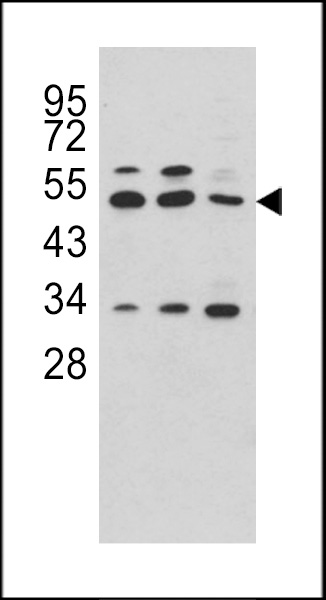CPA4 Antibody (C-term)
Purified Rabbit Polyclonal Antibody (Pab)
- SPECIFICATION
- CITATIONS
- PROTOCOLS
- BACKGROUND

Application
| WB, E |
|---|---|
| Primary Accession | Q9UI42 |
| Reactivity | Human |
| Host | Rabbit |
| Clonality | Polyclonal |
| Isotype | Rabbit IgG |
| Calculated MW | 47351 Da |
| Antigen Region | 305-336 aa |
| Gene ID | 51200 |
|---|---|
| Other Names | Carboxypeptidase A4, 3417-, Carboxypeptidase A3, CPA4, CPA3 |
| Target/Specificity | This CPA4 antibody is generated from rabbits immunized with a KLH conjugated synthetic peptide between 305-336 amino acids from the C-terminal region of human CPA4. |
| Dilution | WB~~1:1000 E~~Use at an assay dependent concentration. |
| Format | Purified polyclonal antibody supplied in PBS with 0.09% (W/V) sodium azide. This antibody is prepared by Saturated Ammonium Sulfate (SAS) precipitation followed by dialysis against PBS. |
| Storage | Maintain refrigerated at 2-8°C for up to 2 weeks. For long term storage store at -20°C in small aliquots to prevent freeze-thaw cycles. |
| Precautions | CPA4 Antibody (C-term) is for research use only and not for use in diagnostic or therapeutic procedures. |
| Name | CPA4 |
|---|---|
| Synonyms | CPA3 |
| Function | Metalloprotease that cleaves hydrophobic C-terminal residues with a preference for -Phe, -Leu, -Ile, -Met, -Tyr and -Val (PubMed:20385563). May function in peptide hormone and/or neuropeptide catabolism (PubMed:20385563). |
| Cellular Location | Secreted. |
| Tissue Location | Fetal expression in the adrenal gland, brain, heart, intestine, kidney, liver and lung. Except for fetal brain that shows no imprinting, expression was found preferentially from the maternal allele |

Thousands of laboratories across the world have published research that depended on the performance of antibodies from Abcepta to advance their research. Check out links to articles that cite our products in major peer-reviewed journals, organized by research category.
info@abcepta.com, and receive a free "I Love Antibodies" mug.
Provided below are standard protocols that you may find useful for product applications.
Background
CPA4 is a member of the carboxypeptidase A/B subfamily. Carboxypeptidases are zinc-containing exopeptidases that catalyze the release of carboxy-terminal amino acids, and are synthesized as zymogens that are activated by proteolytic cleavage. This protein could be involved in the histone hyperacetylation pathway. It is imprinted and may be a strong candidate protein for prostate cancer aggressiveness.
References
Ross,P.L., Cheng,I. BMC Cancer 9, 69 (2009)
Bentley,L., Nakabayashi,K. J. Med. Genet. 40 (4), 249-256 (2003)
Kayashima,T., Yamasaki,K. Hum. Genet. 112 (3), 220-226 (2003)
Hayashida,S., Yamasaki,K. Genomics 66 (2), 221-225 (2000)
If you have used an Abcepta product and would like to share how it has performed, please click on the "Submit Review" button and provide the requested information. Our staff will examine and post your review and contact you if needed.
If you have any additional inquiries please email technical services at tech@abcepta.com.













 Foundational characteristics of cancer include proliferation, angiogenesis, migration, evasion of apoptosis, and cellular immortality. Find key markers for these cellular processes and antibodies to detect them.
Foundational characteristics of cancer include proliferation, angiogenesis, migration, evasion of apoptosis, and cellular immortality. Find key markers for these cellular processes and antibodies to detect them. The SUMOplot™ Analysis Program predicts and scores sumoylation sites in your protein. SUMOylation is a post-translational modification involved in various cellular processes, such as nuclear-cytosolic transport, transcriptional regulation, apoptosis, protein stability, response to stress, and progression through the cell cycle.
The SUMOplot™ Analysis Program predicts and scores sumoylation sites in your protein. SUMOylation is a post-translational modification involved in various cellular processes, such as nuclear-cytosolic transport, transcriptional regulation, apoptosis, protein stability, response to stress, and progression through the cell cycle. The Autophagy Receptor Motif Plotter predicts and scores autophagy receptor binding sites in your protein. Identifying proteins connected to this pathway is critical to understanding the role of autophagy in physiological as well as pathological processes such as development, differentiation, neurodegenerative diseases, stress, infection, and cancer.
The Autophagy Receptor Motif Plotter predicts and scores autophagy receptor binding sites in your protein. Identifying proteins connected to this pathway is critical to understanding the role of autophagy in physiological as well as pathological processes such as development, differentiation, neurodegenerative diseases, stress, infection, and cancer.


